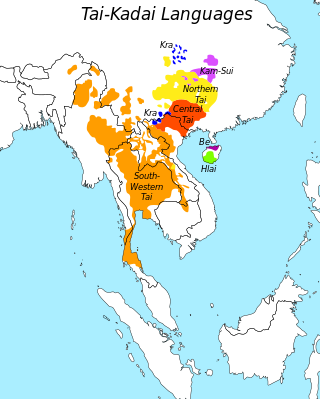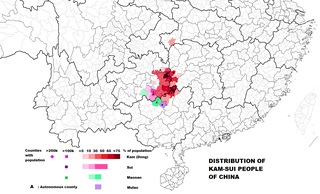Related Research Articles

The Kra–Dai languages, are a language family in mainland Southeast Asia, southern China, and northeastern India. All languages in the family are tonal, including Thai and Lao, the national languages of Thailand and Laos, respectively. Around 93 million people speak Kra–Dai languages; 60% of those speak Thai. Ethnologue lists 95 languages in the family, with 62 of these being in the Tai branch.
The Kam–Tai languages, also called Dong–Tai or Zhuang–Dong in China, are a proposed primary branch of the Kra–Dai language family. However, since the 2000s in China, the names Dong–Tai and Zhuang–Dong have been used to refer to the entire Kra–Dai language family, including the Kra languages, due to the extensive documentation and comparative work done on Kra languages in China starting from the 2000s.

The Kam–Sui peoples are a group of related ethnic groups in China and neighboring portions of Northern Laos and Vietnam. They are defined as speakers of Kam–Sui languages, which belong linguistically to the Kra–Dai languages.
The Kam–Sui languages are a branch of the Kra–Dai languages spoken by the Kam–Sui peoples. They are spoken mainly in eastern Guizhou, western Hunan, and northern Guangxi in southern China. Small pockets of Kam–Sui speakers are also found in northern Vietnam and Laos.
The Austro-Tai languages, sometimes also Austro-Thai languages, are a proposed language family that comprises the Austronesian languages and the Kra–Dai languages.
The Kra languages are a branch of the Kra–Dai language family spoken in southern China and in northern Vietnam.
The Hlai languages are a primary branch of the Kra–Dai language family spoken in the mountains of central and south-central Hainan in China by the Hlai people, not to be confused with the colloquial name for the Leizhou branch of Min Chinese. They include Cun, whose speakers are ethnically distinct. A quarter of Hlai speakers are monolingual. None of the Hlai languages had a writing system until the 1950s, when the Latin script was adopted for Ha.
Sino-Austronesian or Sino-Tibetan-Austronesian is a proposed language family suggested by Laurent Sagart in 1990. Using reconstructions of Old Chinese, Sagart argued that the Austronesian languages are related to the Sinitic languages phonologically, lexically and morphologically. Sagart later accepted the Sino-Tibetan languages as a valid group and extended his proposal to include the rest of Sino-Tibetan. He also placed the Tai–Kadai languages within the Austronesian family as a sister branch of Malayo-Polynesian. The proposal has been largely rejected by other linguists who argue that the similarities between Austronesian and Sino-Tibetan more likely arose from contact rather than being genetic.
Be, also known as Ong Be, Bê, or Vo Limgao, is a pair of languages spoken by 600,000 people, 100,000 of them monolingual, on the north-central coast of Hainan Island, including the suburbs of the provincial capital Haikou. The speakers are counted as part of the Han Chinese nationality in census. According to Ethnologue, it is taught in primary schools.
Laha is a Kra language spoken by approximately 1,400 people out of a total population of 5,686 Laha. It is spoken in Lào Cai and Sơn La provinces, Vietnam. Laha dialects had been documented in 1986 by Russian linguists and in 1996 by American linguist Jerold A. Edmondson. Many Laha can also converse in the Khmu language, and Laha-speaking areas also have significant Black Thai, Kháng, Ksongmul, and Hmong populations.
Proto-Tai is the reconstructed proto-language of all the Tai languages, including modern Lao, Shan, Tai Lü, Tai Dam, Ahom, Northern Thai, Standard Thai, Bouyei, and Zhuang. The Proto-Tai language is not directly attested by any surviving texts, but has been reconstructed using the comparative method.
The Lakkia language, also spelled Lakkja after its IPA transcription, is a Kra–Dai language spoken in Jinxiu Yao Autonomous County, Laibin, East-Central Guangxi, China.
There have been various classification schemes for Southeast Asian languages.
Proto-Hmong–Mien (PHM), also known as Proto-Miao–Yao, is the reconstructed ancestor of the Hmong–Mien languages. Lower-level reconstructions include Proto-Hmongic and Proto-Mienic.
Proto-Hlai is the reconstructed ancestor of the Hlai languages. Proto-Hlai reconstructions include those of Matisoff (1988), Thurgood (1991), Wu (2000), Ostapirat (2004), and Norquest (2007).
Proto-Kra is the reconstructed ancestor of the Kra languages. It was reconstructed in 2000 by Weera Ostapirat in his Ph.D. dissertation.
The East Asian languages are a language family proposed by Stanley Starosta in 2001. The proposal has since been adopted by George van Driem and others.
Proto-Kra–Dai is the proposed reconstructed ancestor of the Kra–Dai languages.
Peter K. Norquest is an American linguist who specializes in Kra–Dai historical linguistics.
Proto-Mienic or Proto-Yao is the reconstructed ancestor of the Mienic languages.
References
- ↑ Thurgood, Graham. 1988. "Notes on the reconstruction of Proto-Kam–Sui." In Jerold A. Edmondson and David B. Solnit (eds.), Comparative Kadai: Linguistic studies beyond Tai, 179–218. Summer Institute of Linguistics Publications in Linguistics, 86. Dallas: Summer Institute of Linguistics and the University of Texas at Arlington.
- ↑ Ostapirat, Weera. 1994a. Speculations on Proto-Kam-Sui breathy sounds. Kadai 4:79–87.
- ↑ Ostapirat, Weera. 1994b. Two series of Proto-Kam-Sui preglottalized nasals. Kadai 4:89–92.
- ↑ Ostapirat, Weera. (2006). Alternation of tonal series and the reconstruction of Proto-Kam-Sui Archived 2021-06-13 at the Wayback Machine . In D.-A. Ho et al. (Eds.), Linguistics Studies in Chinese and Neighboring Languages (pp. 1077–1121). Taipei: Academia Sinica. (ling.sinica.edu.tw(PDF). 2019-12-04 https://web.archive.org/web/20210613073343/http://www.ling.sinica.edu.tw/Files/LL/Docments/Monographs/Linguistics%20Studies%20in%20Chinese%20and%20Neighboring%20Languages/Volume%202/51-Ostapirat.pdf. Archived from the original (PDF) on 2021-06-13. Retrieved 2023-04-27.
{{cite web}}: Missing or empty|title=(help)) - ↑ Peiros, Ilia, 1998. "Comparative Linguistics in Southeast Asia", Pacific Linguistics, Research School of Pacific and Asian Studies, Australian National University.
- ↑ Reconstructing Language Change and Variation. Award #1461492, National Science Foundation.
- 1 2 3 Norquest, Peter (2021). "Classification of (Tai-)Kadai/Kra-Dai languages". The Languages and Linguistics of Mainland Southeast Asia. De Gruyter. pp. 225–246. doi:10.1515/9783110558142-013. ISBN 9783110558142. S2CID 238672319.
- 1 2 Liang Min 梁敏 & Zhang Junru 张均如. 1996. Dongtai yuzu gailun 侗台语族概论 / An introduction to the Kam–Tai languages. Beijing: China Social Sciences Academy Press 中国社会科学出版社. ISBN 9787500416814